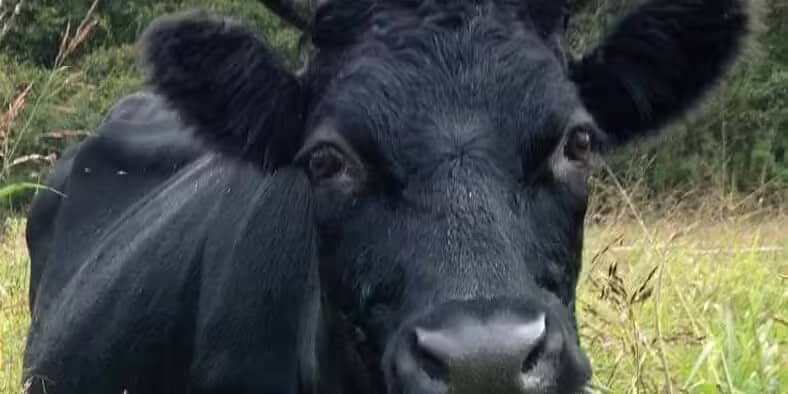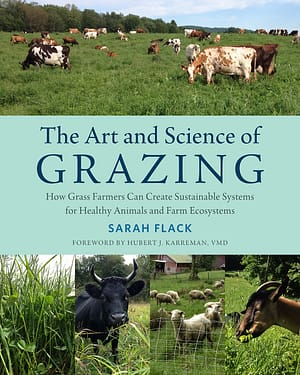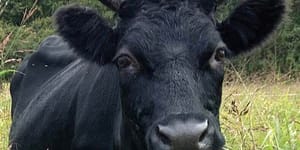Good Grazing Makes for Healthy Pastures, People, and Planet

In her book, The Art of Science and Grazing, nationally known grazing consultant Sarah Flack identifies the key principles and practices necessary for farmers to design, and manage, successful grazing systems.
This book is an essential guide for ruminant farmers who want to crate grazing systems that meet the needs of their livestock, pasture plants, soils, and the larger ecosystem – especially as it pertains to making agriculture a solution in the fight against climate change. Below is an excerpt from her book, which outlines the benefits of good pasture management.
Have you noticed that some pastures seem to run out during the grazing season so that cows have to be fed more in the barn? Have you ever wondered why some pastures become weedy, stay short, or are full of plants the animals won’t eat? Many of these problems are caused by poorly designed grazing systems, or they result from damage to pasture plants and soils caused by poor management.
When done well, grazing management can improve animal well-being, ecological health, and the financial sustainability of the farm.
An effectively designed and managed grass-based livestock operation requires that the farmer understand the basic principles of grazing management and ecology. It also requires an understanding of what pasture plants and livestock need, and how to put that information together with the right infrastructure. This knowledge makes it possible for the farmer to choose which type of grazing system best fits the farm and family goals, and customize it so that the system is practical and works well.
The pasture ecosystem includes many interrelated parts including plants, soils, animals, local weather, and the farmer. (Yes, humans are part of the ecosystem!) Many factors affect the types of plants in a pasture and how vigorously they grow. Such factors can include how animals are being used to harvest the plants and how well manure is being distributed, as well as the impact of hooves, the weather, and the past and current management of soil fertility and health. Grazing systems that are designed and managed with an understanding of these factors create many benefits. However, poorly designed and managed pastures can lead to many problems, including negative impacts on the ecosystem.
For beginner farmers or those new to grass-based livestock farming, the number of suggestions on the “best way” to improve soil fertility, forage quality, and pasture production can be overwhelming.
This is particularly challenging for farmers who have not yet learned the fundamental principles of good grazing management. Without a solid understanding of the basic guidelines of how to set up and manage a pasture system, itís easy to get sidetracked by the latest fads and spend money on unnecessary or impractical infrastructure and inputs. This can result in a system that doesnít meet your quality-of-life goals or the financial needs of the farm, and it can jeopardize the productivity and welfare of the livestock.
To be a good grass farmer, you need technical and scientific knowledge of grazing management and animal husbandry, plus the observation and monitoring skills to see subtle changes over time in livestock, soils, and pasture plants. With this knowledge, farmers have found diverse creative ways to apply good grazing principles to many types of land bases with different types of livestock.
How Grazing Improves Pasture

Well-managed pasture provides low-cost, high-quality feed. This is particularly helpful for farmers who must deal with rising costs of purchased feed, combined with the expense of harvest and storage of forages. With good pasture management, most sheep and beef farms should be able to completely eliminate feeding grain or stored forages during the grazing season. For some dairy farms, it may be possible to significantly reduce or, in some cases, completely eliminate grain feeding. However, at the time of this writing it is probably still more profitable for most dairy farms to supplement pasture with grain, due to the current cost of grain and pay price for milk. (See chapter 11 for more detail on 100 percent grass feeding.)
In addition to lower costs due to reduced supplemental feed purchases, there are also fewer labor and input costs because the livestock harvest their own feed, which reduces or eliminates the need for mechanical harvest, storage, and feeding. There will still be some expense when starting a grazing system, because fencing and some investment in seed and soil fertility may be needed. Still, the benefits of a well-managed system will generally cover the costs!
When pastures are designed and managed well, there will be a better seasonal availability of high-quality pasture. This can allow grazing to start earlier and run later into the fall or winter. This lowers the expense of purchased fuel, labor, and equipment repairs. For example, a small beef herd with just 20 head can consume 8 to 10 round bales a week. At $40 per bale, the farmer can save as much as $400 for each week the grazing season is extended into the fall. This savings can be reinvested in more fence, seed, or fertility inputs. Or it can go into the vacation savings account!
Benefits of Good Grazing ManagementImproved financial sustainability is an important benefit of well-designed and -managed pastures. But lower costs and higher yields are just two of the many positive impacts from grass-based agriculture. There will also be improved living conditions and animal well-being, along with a whole array of ecological benefits. |
Benefits to Animals
|
Benefits to Farmers
|
Benefits to the Planet and Humans
|
Benefits to Livestock and Humans

When their diet is mostly or entirely from pasture, animals produce meat and milk with different amounts and types of nutrients than what grain-fed livestock produce. The nutrients that appear in higher amounts in grassfed meat and milk include carotenoids, vitamin E, omega-3 fatty acids, conjugated linoleic acid (CLA), and other nutrients.
Research on the human benefits of increasing dietary CLA intake indicates that doing so may lower the risk of cancer and heart disease. Research also shows that increasing omega-3 fatty acids in relation to omega-6 fatty acids may reduce the risk of cancer, obesity, diabetes, and other illnesses.1 Grassfed products are also higher in healthy antioxidants, including vitamin E and carotenoids such as lutein, zeaxanthin, and beta-carotene.
This information can be used to provide some new marketing opportunities. It is not surprising that the higher nutritional value of these foods attracts health-minded consumers, and many consumers also appreciate the other benefits of grass farming, including improved animal welfare and environmental health. Many of the ecological benefits of well-managed pasture-based production systems are a result of having higher-density populations of deep-rooted perennial plants and healthy, biologically active soils. Benefits from the perennial soil cover include decreased soil erosion and improved water quality due to improved soil stability and less nutrient runoff. In addition, with the livestock doing the harvesting and manure spreading, there is less fossil fuel used and fewer emissions of greenhouse gases, and carbon is actually sequestered in plants and soil. These perennial pastures are highly diverse, which also improves wildlife habitat.
Recommended Reads
Recent Articles
So you want to start reaping your harvest, but you’re not sure where to start? Learn how to break down the options of harvesting tools!
Read MoreWhat’s so great about oyster mushrooms? First, you can add them to the list of foods that can be grown indoors! They are tasty, easy to grow, multiply fast, and they love a variety of substrates, making oyster mushrooms the premium choice. The following is an excerpt from Fresh Food from Small Spaces by R. J.…
Read MoreEver heard the phrase, “always follow your nose?” As it turns out, this is a good rule of thumb when it comes to chicken manure. Composting chicken manure in deep litter helps build better chicken health, reduce labor, and retain most of the nutrients for your garden. The following is an excerpt from The Small-Scale Poultry…
Read MoreIn her book, The Art of Science and Grazing, nationally known grazing consultant Sarah Flack identifies the key principles and practices necessary for farmers to design, and manage, successful grazing systems. This book is an essential guide for ruminant farmers who want to crate grazing systems that meet the needs of their livestock, pasture plants,…
Read More








